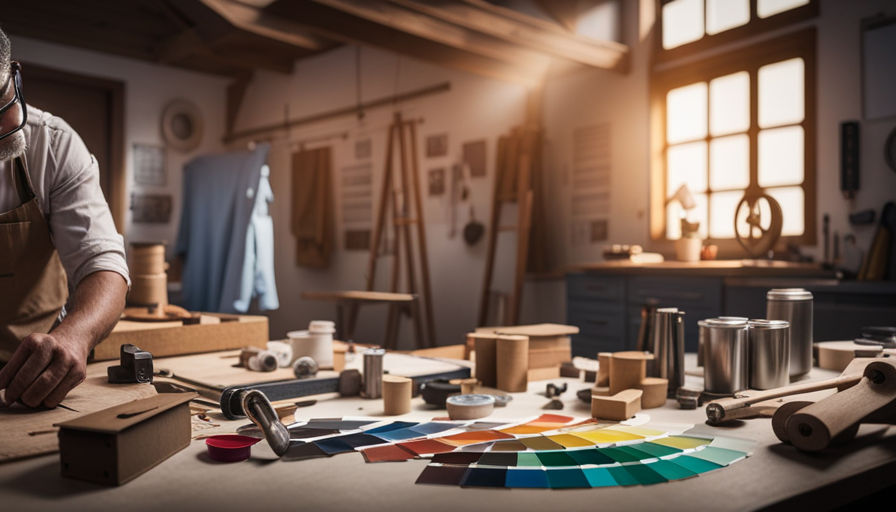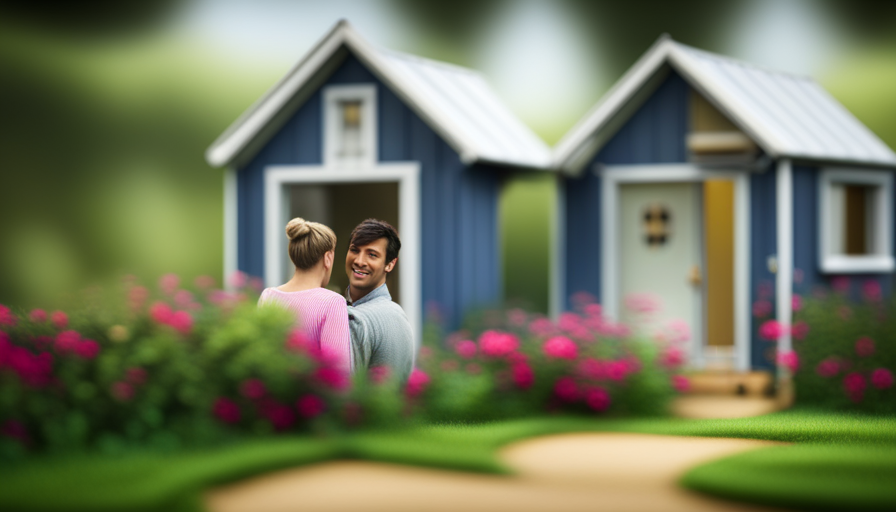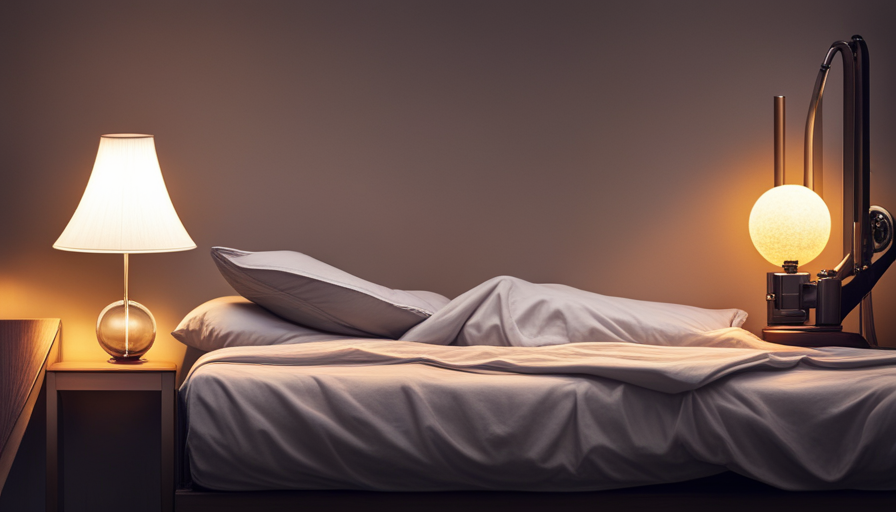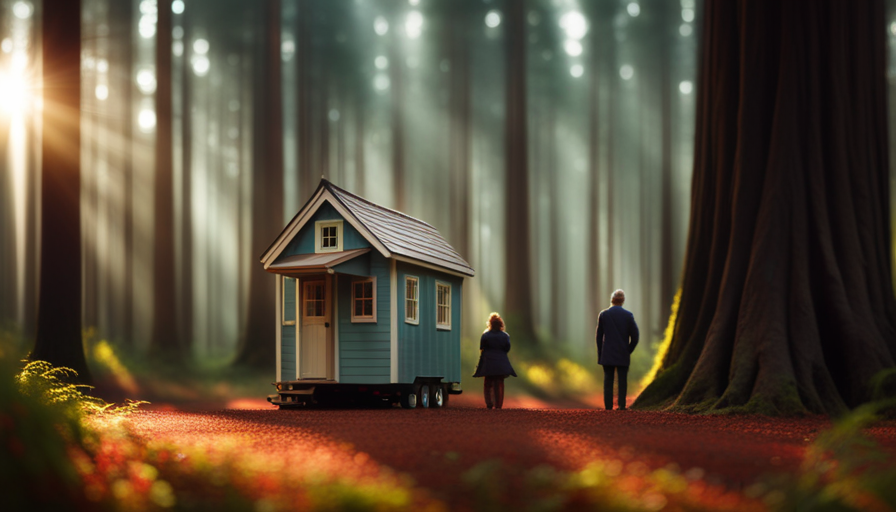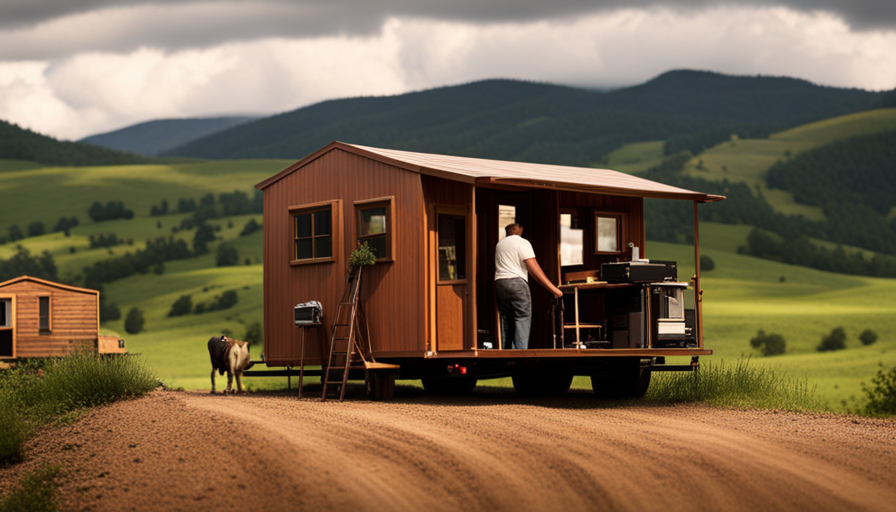Let’s begin immediately by aligning elements next to each other, as it is a powerful way to captivate an audience.
Picture this: a cozy, little haven nestled within the confines of minimal space. A tiny house, where every square inch is meticulously designed to maximize functionality and style. Now, you may be wondering, just how hard is it to create a stunning interior in such a petite dwelling?
Well, fear not, my fellow adventurers of design, for I am here to guide you through the enchanting world of tiny house interiors.
In this article, we will explore the art of transforming limited space into a harmonious haven. We will unravel the secrets of efficient layouts, clever storage solutions, and the magic of light and color. We will delve into the realm of mirrors and illusions, and embrace the elegance of minimalism. We will even discover how to incorporate smart home technology into these miniature abodes.
So, come along with me on this journey, as we seek inspiration from tiny house design communities and learn how to infuse our personal touch into these tiny spaces.
Get ready to redefine what it means to live large in a small space!
Key Takeaways
- Efficient layouts and clever storage solutions are key in tiny house interiors.
- Maximizing natural light is important in tiny house interiors.
- Incorporating smart home technology can enhance ambiance and energy efficiency in a small space.
- Utilizing sustainable materials and creative storage solutions can optimize space and reduce environmental impact in a tiny house.
Understand the Space Constraints
You’ll have to get creative with your interior design to make the most of the limited space in a tiny house. With a smaller footprint, every inch counts, so it’s important to think outside the box when it comes to storage solutions.
One of the keys to maximizing space in a tiny house is utilizing vertical space. Look for opportunities to build up, whether it’s with tall bookshelves that can hold more than just books or utilizing the height of your walls for hanging storage. Think about incorporating hooks or shelves on the walls to keep items off the floor and out of the way.
Another creative storage solution is to think multi-purpose. Look for furniture pieces that can serve more than one function. For example, a coffee table that doubles as a storage ottoman or a sofa that can convert into a bed. This way, you can make the most of every piece of furniture and eliminate the need for extra storage.
In addition to creative storage solutions, it’s also important to plan efficient layouts. Consider the flow of the space and how you can maximize functionality. This may mean sacrificing some traditional furniture pieces in favor of built-in storage or opting for smaller appliances. With careful planning and a resourceful mindset, you can create a functional and beautiful interior in your tiny house.
Plan Efficient Layouts and Storage Solutions
Creating an efficient layout and incorporating clever storage solutions allows for maximized space usage and a visually appealing design within the cozy confines of a small abode. When it comes to interior design for tiny houses, efficient organization is key.
With limited square footage, it’s important to make every inch count. One creative storage idea is to utilize multi-functional furniture, such as a bed that doubles as a storage unit or a coffee table with hidden compartments. This not only saves space but also adds a touch of ingenuity to the overall design.
Another option is to make use of vertical space by installing shelves or hooks on the walls for additional storage. This not only keeps things organized but also creates a visually interesting display.
In addition to efficient organization, choosing light colors and reflective surfaces can help create the illusion of a larger space. Light colors, such as whites and pastels, can make a room feel airy and open. Reflective surfaces like mirrors or glass can also enhance the sense of spaciousness by bouncing light around the room.
By incorporating these design elements, you can create a tiny house interior that feels bright and inviting.
So, let’s dive into the next section and explore how to choose the perfect light colors and reflective surfaces for your tiny home.
Choose Light Colors and Reflective Surfaces
To make your small space feel brighter and more open, consider incorporating light colors and reflective surfaces into your design. Imagine walking into a tiny home that is painted in soothing pastels, giving the illusion of a breezy beachside escape where worries melt away with the tide. By strategically choosing light colors for your walls, furniture, and decor, you can instantly create an airy and spacious atmosphere. Light hues such as soft blues, pale yellows, and creamy whites can make your tiny house feel larger and more inviting.
In addition to light colors, incorporating reflective surfaces can further enhance the illusion of space. Mirrors, for example, can be strategically placed to reflect natural light and create the illusion of depth. Not only do mirrors add a touch of elegance to your tiny home, but they also have the ability to brighten up even the darkest corners.
To maximize natural light in your tiny house, consider positioning mirrors across from windows or installing a skylight. These simple choices can make a significant difference in the overall brightness of your space.
Maximize Natural Light
Imagine waking up in a sun-drenched oasis, where rays of light gently filter through the windows, illuminating every corner of your small space. Maximizing natural light in the interior of a tiny house can transform it into a bright and inviting haven.
One key aspect of natural light optimization is strategic window placement. By strategically placing windows in areas where sunlight is abundant, you can bring the beauty of the outdoors inside, creating the illusion of a larger space.
When designing the interior of a tiny house, it’s crucial to consider the placement of windows carefully. Opt for larger windows that allow ample sunlight to flood the room. Position them in areas where the sun hits directly, such as the east or west-facing walls. This will ensure that your tiny home is filled with natural light throughout the day.
In addition to window placement, consider incorporating skylights or light tubes to bring in even more natural light. These features can be especially beneficial in areas where windows may not be possible, such as in loft spaces or bathrooms.
By maximizing natural light, you can create an airy and spacious feel within your tiny house. The next step in creating the illusion of space is to use mirrors strategically.
Use Mirrors to Create Illusions of Space
Bathing your small space in the reflective glow of mirrors can transport you to a world of infinite possibilities. Using mirrors to create the illusion of space is a clever and effective way to make your tiny house feel larger and more open.
The placement of mirrors requires some creativity and resourcefulness. Consider placing a large mirror on the wall opposite a window to reflect the natural light and make the room appear brighter and more spacious. You can also experiment with different types of mirrors to create visual impact. A floor-to-ceiling mirror can give the illusion of a taller space, while a mirrored backsplash in the kitchen can make it seem wider. Be bold and think outside the box when it comes to mirror placement.
In addition to maximizing space, mirrors can also serve as decorative elements. Choose mirrors with unique frames or interesting shapes to add personality to your tiny house. The key is to use mirrors strategically and thoughtfully, enhancing the overall design and functionality of your space.
Now, let’s transition into the subsequent section about simplifying and decluttering.
Simplify and Declutter
Clear out the unnecessary and simplify your surroundings to create a sense of calm and tranquility in your space. Simplified living is all about decluttering and organizing your tiny house in a way that maximizes functionality and minimizes stress.
Start by ruthlessly getting rid of items that you don’t need or love. Be honest with yourself and ask, "Does this item truly add value to my life?" If the answer is no, let it go. Embrace a minimalist mindset and only keep the essentials.
Once you have decluttered, it’s time to organize. Invest in storage solutions that are specifically designed for small spaces, such as under-bed storage containers and hanging shoe organizers. Make use of vertical space by installing shelves or using wall-mounted organizers. Utilize every nook and cranny to create storage opportunities.
To maintain a simplified living environment, adopt daily habits like putting things away immediately after use and doing regular decluttering sessions. By keeping your space organized and clutter-free, you’ll create a serene atmosphere that allows you to focus on what truly matters.
Now, let’s transition into the next section about embracing minimalism and incorporating multipurpose items.
Embrace Minimalism and Multipurpose Items
To fully embrace a minimalist lifestyle, I must integrate multipurpose items into my living space, allowing for a seamless and sophisticated environment. This means choosing minimalist furniture that not only serves its primary purpose but also offers additional functionality. For example, a sofa with built-in storage compartments or a coffee table that can be transformed into a dining table.
These multipurpose items not only save space but also add a touch of creativity to the interior design.
In addition to multipurpose furniture, creative storage solutions are essential in a tiny house. Utilizing every inch of available space is crucial, so I opt for hidden storage compartments, such as under-bed storage or wall-mounted shelves with hidden compartments. These innovative storage solutions help me keep my belongings organized and out of sight, maintaining a clutter-free environment.
Incorporating smart home technology seamlessly complements the minimalist aesthetic of my tiny house. By integrating smart lighting and temperature control systems, I can create different moods and save energy at the same time. This transition to the next section allows me to explore the benefits of incorporating smart home technology while maintaining the minimalist and sophisticated ambiance of my tiny house.
Incorporate Smart Home Technology
By seamlessly integrating smart home technology into your living space, you can effortlessly control the ambiance and energy efficiency of your minimalist sanctuary, creating a harmonious environment that adapts to your every need.
However, the integration of smart home technology in a tiny house may present some challenges. Limited space and layout constraints can make it difficult to hide wires and devices, requiring careful planning and creative solutions. Additionally, ensuring energy efficiency in a small space is crucial to maximize the limited resources available. Smart thermostats and energy monitoring systems can help regulate the temperature and track energy usage, allowing you to make informed decisions to reduce your carbon footprint.
To overcome integration challenges, consider investing in wireless smart devices that can be discreetly placed around your tiny house. This eliminates the need for extensive wiring and allows for flexibility in their placement. Smart lighting systems can be installed to create different moods and save energy by adjusting brightness and color temperature. Moreover, automated blinds and curtains can be programmed to let in natural light during the day and provide privacy at night, further enhancing energy efficiency.
Transitioning into the next section about personalizing with small decorative touches, it’s important to remember that even in a high-tech tiny house, small decorative elements can add warmth and personality to your space.
Personalize with Small Decorative Touches
As I finish incorporating smart home technology into my tiny house, I can’t help but feel excited about the next step: personalizing the space with small decorative touches. Adding these finishing touches will bring a sense of warmth and personality to my tiny home, making it truly feel like my own.
One way I plan to do this is by incorporating small plants throughout the space. Not only will these plants add a touch of greenery and life, but they will also help to purify the air and create a calming atmosphere. I envision placing a variety of plants on shelves, windowsills, and even hanging from the ceiling, creating a mini indoor garden that will bring a sense of tranquility to my tiny home.
In addition to plants, I also plan to embark on some DIY projects to add unique and personal touches to the interior. I imagine creating a gallery wall with my favorite photos and artwork, using reclaimed wood to build custom shelves, and even making my own throw pillows and curtains. These small projects will not only save me money, but they will also allow me to infuse my own personal style and creativity into the space.
With small decorative touches and DIY projects, my tiny house will truly reflect my personality and style. But before I dive into these projects, I want to seek inspiration from tiny house design communities to ensure that I make the most of my limited space and create a truly functional and beautiful interior.
Seek Inspiration from Tiny House Design Communities
Immersing myself in the vibrant and imaginative world of tiny house design communities, I can’t wait to gather inspiration for transforming my cozy abode into a functional and visually stunning haven. These communities are a treasure trove of ideas and tips that can help me make the most of my limited space.
One aspect that I’m particularly excited about is exploring creative storage solutions. Tiny houses require ingenuity when it comes to storage, and I’m eager to see how others have maximized their space. From hidden compartments under the stairs to cleverly designed built-in shelves, there are endless possibilities to make every nook and cranny work for me.
Additionally, I’m committed to incorporating sustainable materials into my tiny house interior. Not only will this help reduce my environmental footprint, but it’ll also add a unique and rustic charm to my space. I’m excited to see how other tiny house enthusiasts have used reclaimed wood, recycled materials, and eco-friendly finishes to create a sustainable and aesthetically pleasing home.
By immersing myself in the tiny house design communities, I’m confident that I’ll find inspiration and ideas that’ll help me create a functional and visually stunning interior for my tiny house. From clever storage solutions to sustainable materials, these communities offer a wealth of knowledge that’ll guide me in making my cozy abode truly extraordinary.
Frequently Asked Questions
What are some popular color choices for the interior of a tiny house?
When it comes to popular color choices for the interior of a tiny house, there are several options that can create a cozy atmosphere in a small space.
Soft neutrals like cream or light gray can make the space feel open and airy.
For a bolder look, consider using pops of color like vibrant blues or greens.
Additionally, warm earth tones like terracotta or mustard yellow can add a touch of coziness to the space.
Experimenting with different color combinations can truly transform the interior of your tiny house into a stylish and inviting home.
How can I make the most of a small bathroom space in a tiny house?
To make the most of a small bathroom space in a tiny house, I focus on maximizing storage and creating the illusion of more space. I use clever storage solutions like floating shelves and hooks to keep things organized and off the floor.
Mirrors strategically placed can create the illusion of a larger space. I also choose light colors and sleek fixtures to make the bathroom feel bright and airy.
With these tricks, my tiny bathroom feels spacious and functional.
Are there any specific types of furniture that work best in a tiny house?
When it comes to furnishing a tiny house, there are some specific types of furniture that work wonders. Multifunctional pieces are key, such as a sofa that transforms into a bed or a coffee table with hidden storage compartments.
Utilizing vertical space is also crucial, so wall-mounted shelves or hanging organizers can be lifesavers. Additionally, investing in furniture with built-in storage, like ottomans or beds with drawers, helps maximize storage in a tiny house.
With these clever furniture choices, you can make the most of your limited space.
Can you provide examples of multipurpose items that would be useful in a tiny house?
Multipurpose furniture and space-saving storage solutions are essential in a tiny house. They maximize functionality and make the most of limited space.
One example is a sofa that can transform into a bed, providing both seating and sleeping options.
Another example is a coffee table with hidden storage compartments, perfect for stashing away items like blankets or books.
These clever design solutions help create a versatile and efficient interior, making the most of every square inch.
How can I incorporate smart home technology into a tiny house design?
Designing a tiny house is like painting a masterpiece on a tiny canvas. When incorporating smart home technology, I aim to seamlessly intertwine efficiency and functionality.
By embracing energy-efficient technology, such as smart thermostats and LED lighting, I can optimize energy usage. Additionally, I prioritize maximizing storage space by utilizing built-in shelves and hidden compartments.
My meticulous attention to detail ensures that every inch of my tiny house is both smart and stunning.
Conclusion
After going through the process of designing and decorating the interior of a tiny house, I can confidently say that it’s not as hard as it may seem. With careful planning and creative solutions, it’s possible to make the most of the limited space.
One interesting statistic that sheds light on the growing popularity of tiny houses is that the number of tiny house dwellers in the United States has increased by 67% over the past decade. This shows that more and more people are embracing the minimalist lifestyle and finding joy in living in small spaces.
So, if you’re considering a tiny house, don’t be intimidated by the size – embrace the challenge and create a cozy and functional home.
Hi, I’m Emma. I’m the Editor in Chief of Tiny House 43, a blog all about tiny houses. While tree houses are often associated with childhood, they can be the perfect adult retreat. They offer a cozy space to relax and unwind, surrounded by nature. And since they’re typically built on stilts or raised platforms, they offer stunning views that traditional homes simply can’t match. If you’re looking for a unique and romantic getaway, a tree house tiny house might just be the perfect option.
